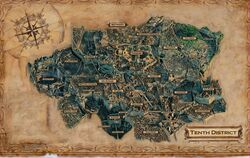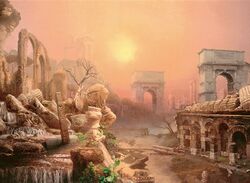Rubblebelt
| Rubblebelt | |
|---|---|
| Information | |
| Plane | Ravnica |
| Colors |
|
| Part of | The Red Wastes |
| Scryfall Statistics | |
|
27 artworks | |
The Rubblebelt is a sprawling, non-contiguous collection of ruined and overgrown urban zones scattered throughout Ravnica, mostly beyond the edge of the Tenth District. These broken districts, long abandoned by the city’s governing structures, are now claimed by the Gruul Clans, who see them as both a symbol of urban decay and a canvas for their primal ideals.
Description

Despite its name, the Rubblebelt is not a single, contiguous region, but rather an "archipelago" of destruction — cracked streets, crumbling tenements, collapsed bridges, and shattered infrastructure arranged in pockets of varying sizes. These areas form a band of ruined and less ruined cityscapes collectively known as the Rubblebelt. Over time, nature has begun to reclaim parts of the Rubblebelt; vines creep across rusting girders, weeds choke abandoned avenues, and wild beasts roam freely. The Gruul celebrate this slow return to wildness, seeing it as proof that civilization is doomed to fall before the power of the untamed world.
The Rubblebelt marks a sharp contrast with the dense core of Ravnica City. The open sky dominates its horizon, and the noise of the metropolis fades into a distant murmur, sometimes blocked entirely by Azorius noise wards set up near city limits. At night, it becomes a dark, lanternless wilderness, inhospitable to outsiders and city-dwellers.
Although they are distinct, the Rubblebelt abuts the Utvara Valley, and both areas are claimed by the Gruul, despite legal declarations by the Orzhov that say otherwise.[1]
The Gruul Clans are the primary occupants of the Rubblebelt, which is the location of Skarrg, the closest thing they have to a guild hall. These warbands and shamans shun the laws and order of the city, living off the land and in conflict with those who would rebuild or repurpose their territory. Gruul encampments range from loosely organized nomadic groups to larger, semi-permanent settlements led by warleaders like Nikya of the Old Ways.
Despite Gruul dominance, the Rubblebelt also draws outsiders with radical visions. Some Selesnya missionaries, such as the evangel Cecilee, have tried to plant healing centers and gardens there, hoping to form a bridge between the wild and the orderly. These efforts are usually tolerated only so long as they do not challenge Gruul independence.
To the Gruul, the Rubblebelt is sacred ground — proof of civilization's failure and a battleground for reclaiming Ravnica’s future. The clans conduct rites, settle disputes, and train warriors among the wreckage. Many believe the Rubblebelt will someday spread across the city, as the unnatural order of the guilds gives way to the raw truth of nature. To most Ravnicans, however, the Rubblebelt is a place of danger and exile — lawless, desolate, and often avoided.
Locations
- Axebane Forest - a sentient forest under the protection of an order of Druids.
- The Cairn of Years' March - the ruin of a huge colosseum.
- Mahovana, The Haven of Moss - a ruined part of the city, covered by large trees.[2]
- Oakchar - a fifty-foot-tall, partially petrified oak used to display the skulls of fallen Gruul chieftains.
- Skarrg
- the gutted, cratered remains of a massive palace. A place of tradition for the Gruul.
History
In 4558 AR, during a time of tentative peace, the elven Selesnyan druid Cecilee established a healing outpost, or vernadi, in the Rubblebelt, hoping to bring new plant life and harmony to the devastated region. As her work drew her closer to the Gruul, she began to adopt their wilder ideals, treating their wounded and even taking in an abandoned Gruul infant, naming him Zi. When Gruul warriors from Nikya's clan demanded the child back, Cecilee refused, straining the fragile alliance. Eventually, her outpost was attacked by the Cult of Rakdos, led by Massacre Girl, who slaughtered Cecilee’s followers and destroyed the verdant sanctuary. Cecilee herself was killed, unaware that her adopted son Zi had survived, hidden away and later rescued by her brother Ruzi.[3]
Ruzi, who had arrived too late to stop the massacre, vowed vengeance upon the Rakdos. Realizing the city’s guilds would never bring justice, Ruzi officially broke from the Conclave and turned to the Gruul. Though his plea to Nikya of the Old Ways, leader of the Zhur-Taa clan, initially seemed futile, the truth of Rakdos' involvement spurred her to declare a blood feud against the cult. Ruzi swore to raise Zi and burn down the city that allowed such evil to go unpunished.[4]
A short time later, Domri Rade traveled from the Rubblebelt to Utvara to perform "the Burying", a coming-of-age ceremony that all Gruul undergo. The stress of the experience caused his planeswalker spark to ignite, sending him to Alara from inside the sarcophagus he was buried in. When Domri returned to the Rubblebelt, the tribe's shaman Sabast declared him to have passed the trial, however strangely it was done.[1][5]
Gallery
-
Gruul Turf
-
Gruul Guildgate
-
Gruul Guildgate variant
-
Gruul Guildgate variant
-
Gruul Guildgate variant
-
Skarrg, the Rage Pits
In-game references
- Represented in:
- Associated cards:
- Depicted in:
- Quoted or referred to:
References
- ↑ a b Adam Lee (2013) - The Burying, part 1
- ↑ Nicky Drayden (October 10, 2018). "Under the Cover of Fog". magicthegathering.com. Wizards of the Coast.
- ↑ Jenna Helland (2012). "In Praise of the Worldsoul, part 2". magicthegathering.com. Wizards of the Coast.
- ↑ Jenna Helland (2012). "In Praise of the Worldsoul, part 3". magicthegathering.com. Wizards of the Coast.
- ↑ Adam Lee (2013) - The Burying, part 2






